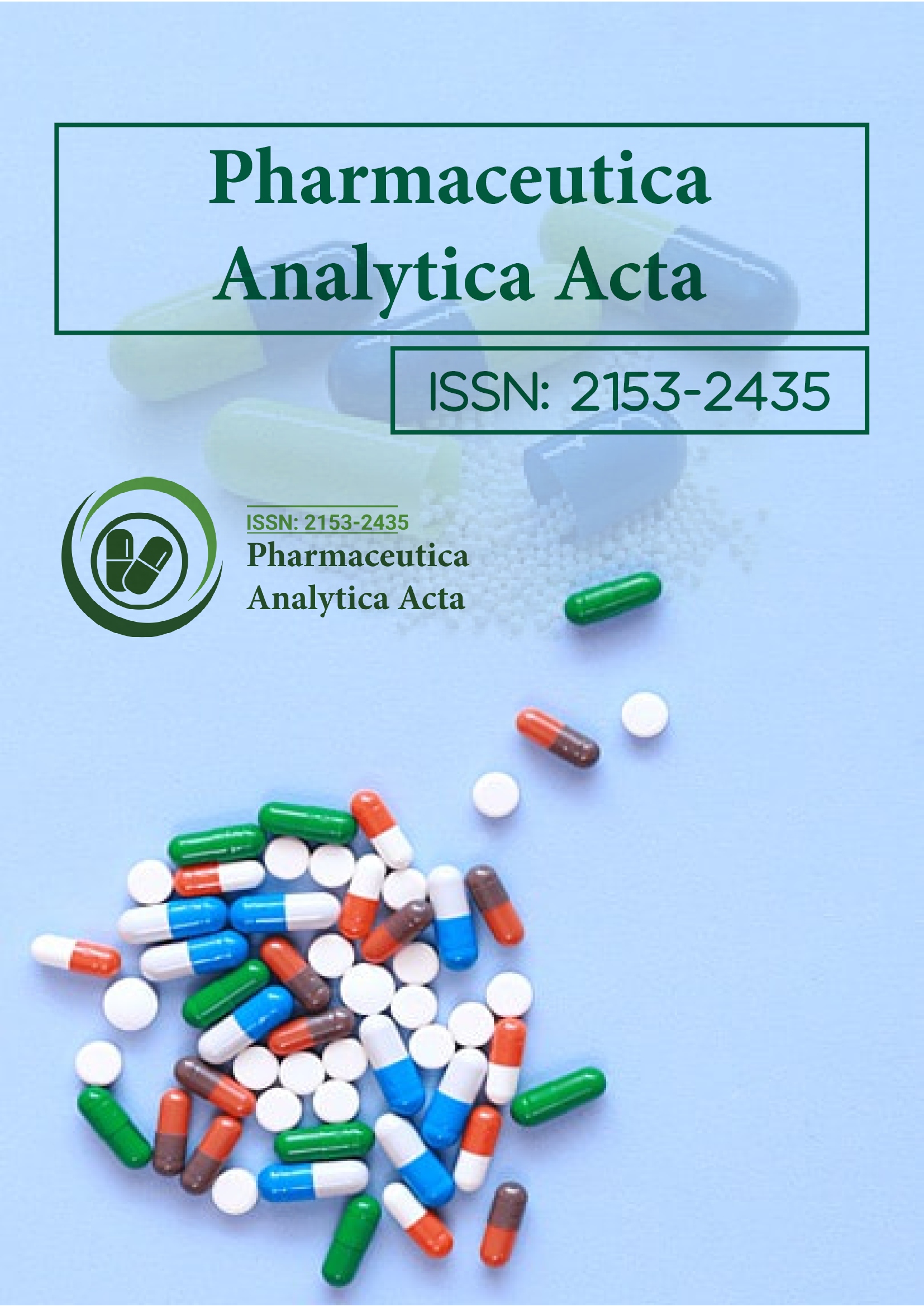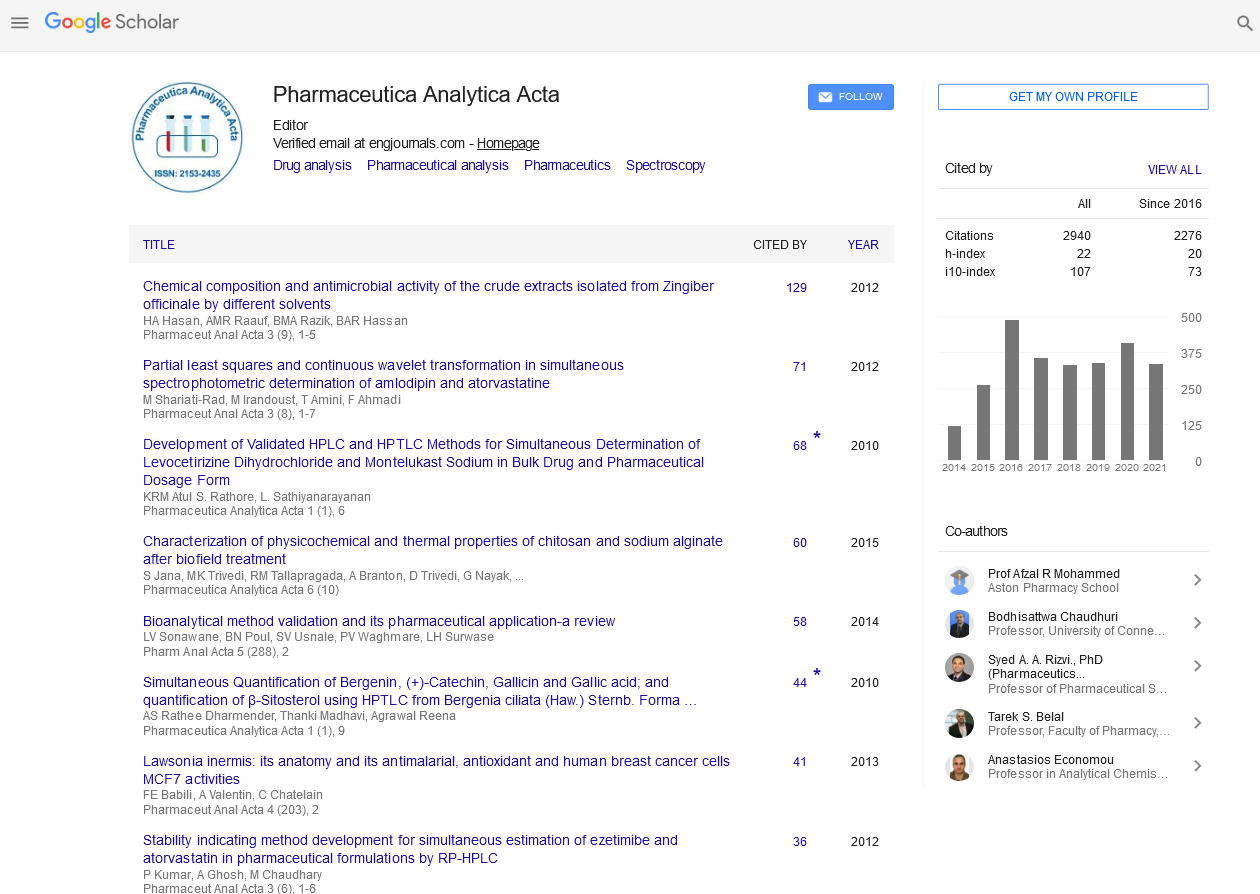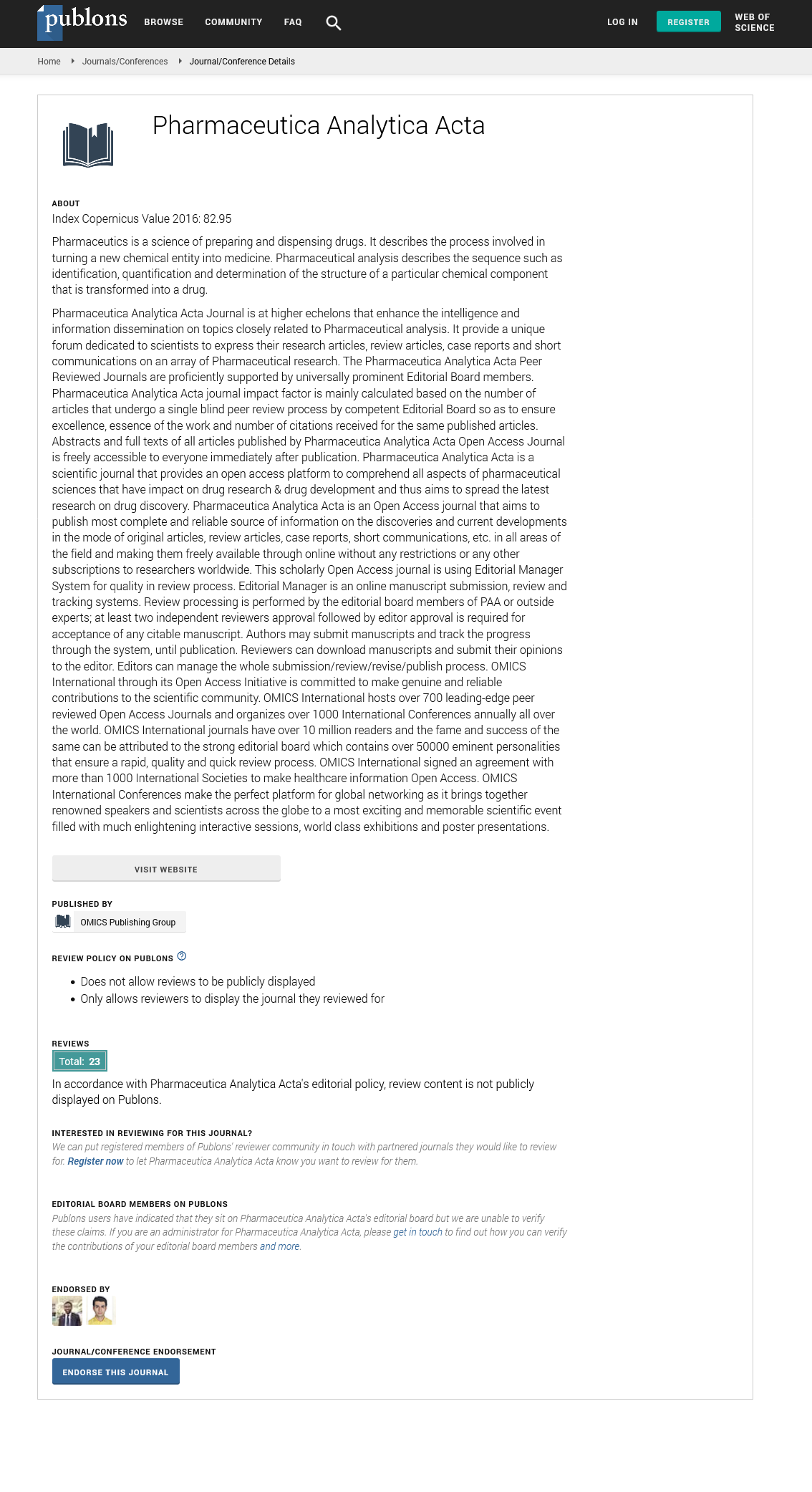Indexed In
- Open J Gate
- Genamics JournalSeek
- Academic Keys
- JournalTOCs
- The Global Impact Factor (GIF)
- China National Knowledge Infrastructure (CNKI)
- Ulrich's Periodicals Directory
- RefSeek
- Hamdard University
- EBSCO A-Z
- OCLC- WorldCat
- Publons
- Geneva Foundation for Medical Education and Research
- Euro Pub
- Google Scholar
Useful Links
Share This Page
Journal Flyer

Open Access Journals
- Agri and Aquaculture
- Biochemistry
- Bioinformatics & Systems Biology
- Business & Management
- Chemistry
- Clinical Sciences
- Engineering
- Food & Nutrition
- General Science
- Genetics & Molecular Biology
- Immunology & Microbiology
- Medical Sciences
- Neuroscience & Psychology
- Nursing & Health Care
- Pharmaceutical Sciences
Perspective - (2025) Volume 16, Issue 2
Advancements in Analytical Technologies for Modern Pharmaceutical Science
Camille Moreau*Received: 31-May-2025, Manuscript No. PAA-25-30221; Editor assigned: 02-Jun-2025, Pre QC No. PAA-25-30221; Reviewed: 16-Jun-2025, QC No. PAA-25-30221; Revised: 21-Jun-2025, Manuscript No. PAA-25-30221; Published: 30-Jun-2025, DOI: 10.35248/2153-2435.25.16.819
Description
The landscape of pharmaceutical analysis is continually evolving as drug development becomes more complex and diverse. Modern medications, including biopharmaceuticals, combination therapies and advanced delivery systems, present challenges that require innovative analytical approaches. In response, researchers are increasingly exploring emerging technologies that improve measurement accuracy, reduce sample requirements and accelerate laboratory workflows. These developments not only enhance laboratory efficiency but also contribute to the reliability and reproducibility of pharmaceutical data, which are critical for regulatory compliance and patient safety. One area of significant advancement is microfluidics, a technology that enables manipulation of small volumes of liquids in channels with dimensions of tens to hundreds of micrometers. Microfluidic platforms allow precise control over sample handling, mixing and separation, which reduces reagent consumption and allows rapid analysis. In pharmaceutical analysis, microfluidics can be applied to drug quantification, stability assessment and metabolite detection. By integrating separation techniques, such as electrophoresis or liquid flow-based methods, within a microfluidic chip, laboratories can achieve high-throughput analysis without sacrificing accuracy. This technology is particularly valuable when sample availability is limited, such as with biological specimens from clinical trials or rare biopharmaceutical products.
Biosensors represent another rapidly developing tool in pharmaceutical science. These devices couple a biological recognition element, such as an enzyme, antibody, or nucleic acid, with a physicochemical transducer to detect analytes. In drug analysis, biosensors enable rapid, selective and sensitive detection of active ingredients, impurities, or degradation products. For instance, enzyme-based sensors can monitor enzymatic reactions linked to drug metabolism, while immunosensors can quantify protein-based therapeutics or antibodies. Recent work also highlights portable biosensor systems that facilitate at-line or on-site measurements in manufacturing environments, reducing the need to transport samples to central laboratories and thus saving time and resources. Mass-spectrometric techniques have also advanced substantially, with ambient ionization methods allowing direct analysis of samples with minimal preparation. Techniques such as desorption electrospray ionization enable rapid identification of drugs, metabolites, or contaminants directly from surfaces or complex matrices. By combining high sensitivity with minimal sample handling, these approaches reduce analysis time and potential sample loss while preserving measurement accuracy. Integration of mass spectrometry with chromatographic separation or microfluidics further enhances specificity and throughput, making it suitable for both research and quality control applications.
Automation and data-driven analysis have become increasingly important in pharmaceutical laboratories. Modern instruments often generate vast amounts of data, including complex spectra or chromatograms, which can be difficult to interpret manually. By connecting analytical instruments to machine-learning models or advanced software, laboratories can automate peak detection, impurity recognition and trend analysis. These tools not only reduce operator variability but also allow real-time monitoring of laboratory processes, leading to more consistent results. In production settings, automated data analysis can help identify deviations early, prevent errors and maintain consistent quality in drug products. High-throughput systems that combine miniaturization, automation and rapid detection methods are gaining traction in pharmaceutical analysis. Such systems are capable of processing hundreds or even thousands of samples per day, which is particularly advantageous for drug discovery, formulation screening, or stability testing. Miniaturized assays reduce the consumption of expensive reagents and samples while maintaining sensitivity and precision. When coupled with automated liquid handling and integrated detection technologies, these systems allow laboratories to achieve significant efficiency gains without compromising data reliability.
Despite these advantages, the adoption of emerging technologies in pharmaceutical analysis requires careful evaluation. New methods must demonstrate equivalence or superiority to established techniques in terms of sensitivity, specificity, reproducibility and compliance with regulatory standards. Comparative studies are essential to assess performance across different sample types, drug classes and laboratory conditions. Such studies provide the necessary confidence for researchers, regulatory authorities and manufacturers to integrate novel methods into routine practice. Application in real-world scenarios adds another layer of validation. Technologies must prove effective not only in controlled laboratory settings but also in practical pharmaceutical environments. For example, measuring active drug concentration, monitoring degradation under stability conditions, or assessing formulation uniformity in manufacturing lines are critical tasks where emerging analytical technologies must perform reliably. Demonstrating operational feasibility, reproducibility and ease of integration ensures that laboratories can confidently adopt these innovations for day-to-day operations.
In conclusion, emerging analytical technologies are transforming the field of pharmaceutical science. Microfluidics, biosensors, advanced mass-spectrometry methods, automated data analysis and high-throughput miniaturized systems offer improved efficiency, accuracy and adaptability. When carefully validated and applied in practical settings, these tools support the evolving demands of drug development, quality control and regulatory compliance. As the pharmaceutical industry continues to advance, these technologies will play an essential role in ensuring reliable, timely and reproducible measurements that uphold the safety and efficacy of drug products.
Citation: Moreau C (2025). Advancements in Analytical Technologies for Modern Pharmaceutical Science. Pharm Anal Acta. 16:819.
Copyright: © 2025 Moreau C. This is an open-access article distributed under the terms of the Creative Commons Attribution License, which permits unrestricted use, distribution and reproduction in any medium, provided the original author and source are credited


